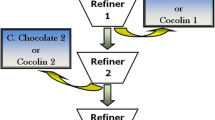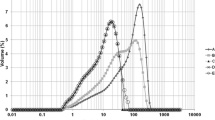Abstract
Control of chocolate viscosity is vital to its quality and production cost, and directly influenced by solids particle size distribution (PSD) and composition. Effects of PSD and composition on rheological properties of molten dark chocolate were investigated by varying PSD [D90 (90% finer than this size) of 18, 25, 35 and 50 μm], fat 25, 30 and 35% and lecithin (0.3 and 0.5%) using a shear rate-controlled rheometer. PSD, fat and lecithin content significantly affected all rheological parameters, with significant interaction among factors. Increasing particles size gave significant reductions in Casson plastic viscosity, Casson yield value, yield stress, apparent viscosity and thixotropy, with greatest effect with 25% fat and 0.3% lecithin, which reduced with increasing fat and lecithin contents. Statistical analysis revealed that fat exerts the greatest effect on the variability in all the rheological properties followed by PSD and lecithin. PSD, fat and lecithin could be manipulated to control dark chocolate rheology, influencing quality whilst reducing production cost.




Similar content being viewed by others
References
Beckett ST (2003) Int J Dairy Technol 56(3):139–142. doi: 10.1046/j.1471-0307.2003.00099.x
Ziegleder G (1992) In: Schoko-Technic 92, International ZDS-Fachtagung, sic-12, Solingen, Germany, pp 24–28
Servais C, Ranc H, Roberts ID (2004) J Tex Stud 34:467–497. doi: 10.1111/j.1745-4603.2003.tb01077.x
Tscheuschner HD, Wunsche D (1979) In: Sherman P (ed) Food texture and rheology. Academic, New York, pp 355–368
Beckett ST (1999) Industrial chocolate manufacture and use, 3rd edn. Blackwell, Oxford, pp 153–181, 201–230, 405–428, 460–465
Vavreck AN (2004) Int J Food Sci Technol 39:465–468. doi: 10.1111/j.1365-2621.2004.00805.x
Schantz B, Rohm H (2005) Lebensm–Wiss U-Technol 38:41–45
International Confectionery Association (ICA) (2000) Viscosity of cocoa and chocolate products. Analytical Method 46. Available from CAOBISCO, rue Defacqz 1, B-1000 Bruxelles, Belgium
Bouzas J, Brown BD (1995) Ingredient interactions. In: Gaonkar AD (ed) Effects on food quality. Marcel and Dekker, New York, pp 451–528
Sokmen A, Gunes G (2006) LWT. Food Sci Technol 39:1053–1058. doi: 10.1016/j.lwt.2006.03.002
OICCC (1973) Viscosity of chocolate. Determination of Casson yield value and Casson plastic viscosity. OICC, London, p 10
Beckett ST (2000) The science of chocolate. Royal Society of Chemistry, Paperbacks, pp 12–52
Mongia G, Ziegler GR (2000) Int J Food Prop 3:137–147
Ziegler GR, Mongia G, Hollender R (2001) Int J Food Prop 4:353–370
Awua PK (2002) Processing and chocolate manufacture in Ghana. David Jamieson and Associates Press Inc, Essex, pp 24–46
Jeffery MS (1993) Food Technol 47(1):141–144
Whitefield R (2005) Making chocolates in the factory. Kennedy, London, pp 25–56
Codex Revised Standard (2003) Codex Alimentarius Commission Revised Standard on Cocoa Products and Chocolate. Report of the Nineteenth Session of the Codex Committee on Cocoa Products and Chocolate. Alinorm 03/14, pp 1–37
European Commission Directive (2000) European Commission Directive 2000/36/EC on Cocoa and Cocoa Products. Official Journal of the European Communities, L 197/19–25
ICA (1998) Determination of moisture content of Cocoa and Chocolate products, Analytical Method 26, Available from CAOBISCO, rue Defacqz 1, B-1000 Bruxelles, Belgium
ICA (1990) Determination of fat content of Cocoa and Chocolate Products. Analytical Method 37, Available from CAOBISCO, rue Defacqz 1, B-1000 Bruxelles, Belgium
Aeschlimann JM, Beckett ST (2000) J Text Stud 31:541–576. doi: 10.1111/j.1745-4603.2000.tb01019.x
Ziegler G, Hogg R (1999) In Beckett ST (ed) Industrial chocolate manufacture and use. Chapman & Hall, New York, pp 182–199
Seguine ES (1988) Manuf Confect 11:57–63
Servais C, Jones R, Roberts I (2002) J Food Eng 51:201–208. doi: 10.1016/S0260-8774(01)00056-5
Dhonsi D, Stapley AGF (2006) J Food Eng 77:936–942. doi: 10.1016/j.jfoodeng.2005.08.022
Chevalley J (1999) In Beckett ST (ed) Industrial chocolate manufacture and use. Chapman & Hall, New York, pp 182–199
Prasad V, Trappe V, Dinsmore AD, Segre PN, Cipelletti L, Weitz DA (2003) Rideal lecture. Faraday Discuss 123:1–12
Haedelt J, Pyle DL, Beckett ST, Niranjan K (2005) J Food Sci 70(2): 159–164. doi: 10.1111/j.1365-2621.2005.tb07090.x
Vernier F (1998) Influence of emulsifiers on the rheology of chocolate and suspensions of cocoa and sugar particles in oil. PhD Thesis, Department of Chemistry, University of Reading
Yoo B, Rao MA, Steffe JF (1995) J Text Stud 26:1–10. doi: 10.1111/j.1745-4603.1995.tb00780.x
Chhabra RP (2007) Bubbles, drops and particles in non-Newtonian fluids. 2nd edn. CRS Press, Boca Raton, USA, p 126
Cheng DC-H (2003) Rheology Acta 42:372–382
Acknowledgments
This study was co-funded by the Government of Ghana and Nestlé Product Technology Center (York, UK). The sponsors are gratefully acknowledged for the Research Support. We thank Steve Beckett, Angela Ryan, Jeremy Hargreaves, Angel Manez and Joselio Vieira (Nestlé PTC, York) for expert technical assistance.
Author information
Authors and Affiliations
Corresponding author
Rights and permissions
About this article
Cite this article
Afoakwa, E.O., Paterson, A. & Fowler, M. Effects of particle size distribution and composition on rheological properties of dark chocolate. Eur Food Res Technol 226, 1259–1268 (2008). https://doi.org/10.1007/s00217-007-0652-6
Received:
Revised:
Accepted:
Published:
Issue Date:
DOI: https://doi.org/10.1007/s00217-007-0652-6




